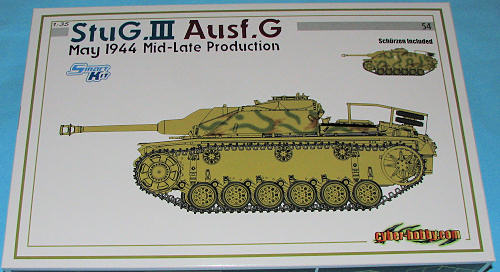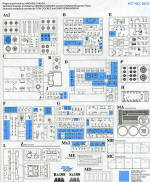
Cyber-hobby 1/35 StuG III Ausf G (May 1944 Mid-Late Production)
| KIT #: | 6412 |
| PRICE: | $67.00 MSRP |
| DECALS: | Four options |
| REVIEWER: | Scott Van Aken |
| NOTES: | Smart Kit |

| HISTORY |
Overall, Sturmgeschütz series assault guns proved very successful and served on all fronts as assault guns and tank destroyers. Although Tigers and Panthers have earned a greater notoriety, assault guns collectively destroyed more tanks. Because of their low silhouette, StuG IIIs were easy to camouflage and a difficult target. Sturmgeschütz crews were considered to be the elite of the artillery units. Sturmgeschütz units held a very impressive record of tank kills – some 20,000 enemy tanks by the spring of 1944.As of April 10, 1945, there were 1,053 StuG IIIs and 277 StuH 42s in service. Approximately 9,500 StuG IIIs of various types were produced until March 1945 by Alkett and a small number by MIAG.
In terms of the resources expended in their construction, the StuG assault guns were extremely cost-effective compared to the heavier German tanks, though in the anti-tank role, it was best used defensively, as the lack of a turret would be a severe disadvantage out in the open. As the German military situation deteriorated later in the war, more and more StuG guns were constructed in comparison to tanks, in an effort to replace losses and bolster defences against the encroaching Allied forces.
In 1944, the Finnish Army received 59 StuG III Ausf. Gs from Germany (30 Stu 40 Ausf.G and 29 StuG III Ausf. G) and used them against the Soviet Union. These destroyed at least 87 enemy tanks for a loss of only 8 StuGs (some of these were destroyed by their crews to avoid capture). After the war, they were the main combat vehicles of the Finnish Army until the early 1960s. These StuGs gained the nickname "Sturmi" which can be found in some plastic kit models.
StuG IIIs were also exported to other nations like Bulgaria, Hungary, Italy, Romania, and Spain.
Many German Sturmgeschütz IIIs were captured by Yugoslav Partisans. After the war, they were used by the Yugoslav Peoples Army until the 1950s.
After the Second World War, the Soviet Union donated some of their captured German vehicles to Syria, which continued to use them at least until the Six Days War (1967).
Today, examples have been kept in running condition, including one seen in the movie Mr. Bean's Holiday.
StuG III Ausf. G (Sd.Kfz. 142/1; Dec 1942– Apr 1945, 7,720 produced, 173 converted from Pz.Kpfw. III chassis): The final, and by far the most common, of the StuG series. The Ausf. G used the hull of the Pz.Kpfw. III Ausf. M. Upper superstructure was widened: welded boxes on either sides were abandoned. This new superstructure design increased its height to 2160mm. From May 1943, side hull skirts (schurzen) were fitted to G models for added armor protection particularly against anti-tank rifles. Side skirts were retro-fitted to some Ausf. F/8 models. Side skirts were also to be fitted to all front line StuGs and tanks by June 1943 in preparation for the battle of Kursk. Mountings for side skirts proved inadequate, many were lost. From March 44, improved mounting was introduced, as a result side skirts are more often seen with late model Ausf G. From May 1943, 80mm thick plates were used for frontal armor instead of two plates of 50mm+30mm. However, backlog of completed 50mm armors exited. For those, 30mm additional armors still had to be welded or bolted on, until Oct 1943.
| THE KIT |
 Here is another of Cyber-hobby/Dragon's Smart kits with the individual track links. While some decry the additional parts count, those who built a lot of armor kits find this to be the best representation of the vehicle's track system. Typical of many Cyber-hobby boxings, this is a one-shot release of a specific time and variant, that being the May 1944 mid-late production vehicle. One of the highlights for many are the quality etched side skirts that one can choose to fit in place. There is also a nicely done photo etch rack above the engine that can be used to hold a variety of additional bits and pieces. These vehicles were often seen with extra stuff on them in the way of supplies and crew items.
Here is another of Cyber-hobby/Dragon's Smart kits with the individual track links. While some decry the additional parts count, those who built a lot of armor kits find this to be the best representation of the vehicle's track system. Typical of many Cyber-hobby boxings, this is a one-shot release of a specific time and variant, that being the May 1944 mid-late production vehicle. One of the highlights for many are the quality etched side skirts that one can choose to fit in place. There is also a nicely done photo etch rack above the engine that can be used to hold a variety of additional bits and pieces. These vehicles were often seen with extra stuff on them in the way of supplies and crew items. 
Cyber-hobby's instructions are superbly drawn and provide color information in both Gunze and Model Master references. Markings are for four tanks, three of them shown with or without the side skirts. #210 is from an Unidentified unit in Europe in 1944 while #5 is with the Panzer Lehr Division in Normandy during 1944. The tank with the large brown patches is from 9 Panzer Division in Arnhem during 1944 while the final tank with splashes of white is from an unidentified Eastern Front unit.
| CONCLUSIONS |
Another superb armor kit and a subject that seems to be quite popular judging from what I've seen displayed at shows. Quick build it is not, but the end results are well worth the effort.
| REFERENCES |
January 2011
Thanks to www.dragonmodelsusa.com for the preview kit. Get yours at your local shop or on-line retailer.
If you would like your product reviewed fairly and fairly quickly, please contact the editor or see other details in the Note to Contributors.